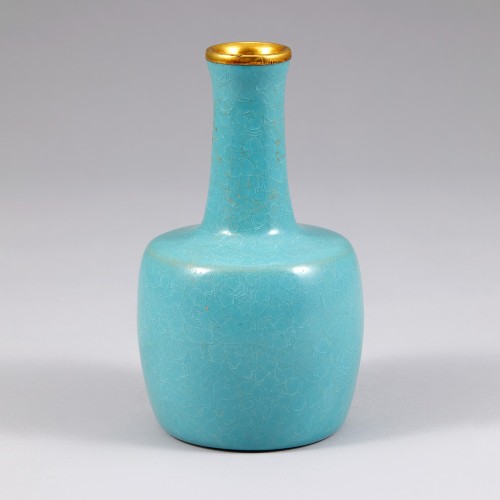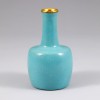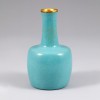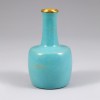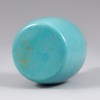본문
이 병은 북송(北宋, 960~1127)의 5대 명요(名窯) 가운데 하나인 여요(汝窯)에서 제작된 도자입니다. 이 도자는 좁고 긴 목에서부터 각이 진 어깨선, 안정적인 평저(平底)의 생김새가 망치를 연상하게 하여 지추병(紙槌瓶)이라 부릅니다. 구연부(口緣部)는 금(金)을 덧씌운 금구(金口)로 제작되었습니다. 금구로 제작된 도자는 황족이나 귀족이 사용한 것으로 추정됩니다.
전체 표면은 천청유(天青釉)로 시유되었습니다. 은은하고 부드러운 하늘빛이 감돌며 깊은 색감을 자아냅니다. 표면에는 자연스럽게 형성된 잔잔한 빙렬(氷裂)이 있습니다. 이 병의 바닥에는 지정지마흔(芝丁之麻痕)이 보입니다. 지정지마흔은 작은 점들이 굽바닥에 남아 있는 흔적입니다. 이러한 흔적은 굽에 규석 받침을 사용하여 굽기 때문에 나타납니다. 이는 유약을 도자 전체에 시유하기 위해 사용한 고유의 번조 방식입니다. 여요는 북송 휘종(徽宗)의 명으로 궁중 납품용 도자기만을 제작하였으며, 전하는 수량도 극히 드물어 귀중한 유물입니다.
此瓶是北宋(960–1127年)五大名窑之一的汝窑所烧制的瓷器。由于其瓶颈细长,肩部棱角分明,底部平稳,其整体形状让人联想到纸槌,因此被称为“纸槌瓶”。口沿镶有金色装饰,通常认为镶金的瓷器是为皇族或贵族使用而制作的。
整件器物通体施以天青釉,釉色温润柔和,泛着淡淡天光般的青蓝色,呈现出深邃的色感。表面可见自然形成的细小开片。瓶底可见“支钉芝麻痕”,即底部留下的细小点状痕迹,这是由于在烧制过程中使用了支钉所致,是为了使整器都能施釉而采用的独特烧成方式。汝窑在北宋徽宗时期专为宫廷烧制御用瓷器,传世数量稀少,是极为珍贵的文物。
This vase is a ceramic piece produced at the Ru kiln, one of the five great kilns of the Northern Song Dynasty (960–1127). Due to its form—featuring a narrow, elongated neck, sharply angled shoulders, and a stable flat base—it resembles a paper mallet and is thus called a zhichui ping (紙槌瓶), or “paper mallet vase.” The rim is overlaid with gold, referred to as jinkou (金口, “gold mouth”). Vessels with such gold rims are believed to have been used by royalty or aristocrats.
The entire surface is coated in celadon glaze, producing a soft, subtle sky-blue hue with a deep and refined tone. Delicate, naturally formed crackles are visible across the glaze. On the base of the vase, traces known as Zhidingzhimahen (芝丁之麻痕) can be seen—small dot-like marks left on the foot. These result from firing the piece on a quartz support ring, a technique used to glaze the entire body evenly.
Ru ware was produced exclusively by imperial order under Emperor Huizong of the Northern Song and supplied only to the royal court. Surviving pieces are exceedingly rare, making this a highly valuable artifact.
